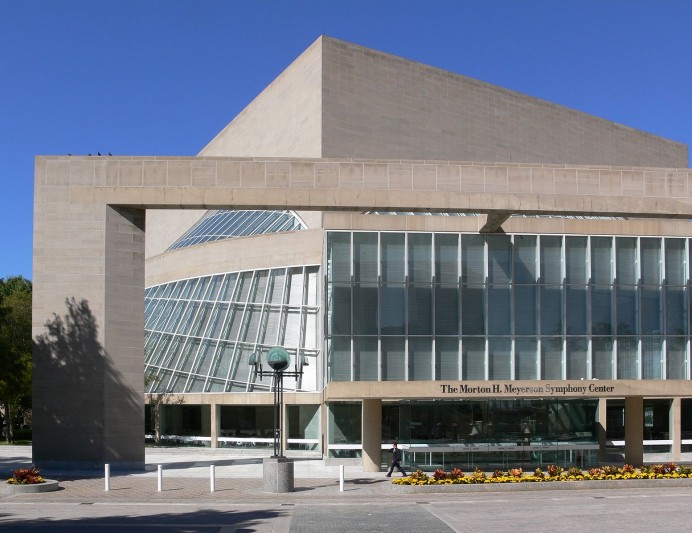
You may want to pause to admire the Meyerson Symphony Hall across the street from it, where you can appreciate the architecture by I.M. Pei which deliberately uses the motifs of square and circle in opposition to each other to create dramatic tension. Look for all of the places where you can see circles inside of squares and vice versa. You may also want to take note of the window framing that slants up the side of the curved windows on the left-hand side of the building in this view. Since that window has a larger circular footprint at its bottom than an its top, it is a section of a cone, and the framing appears to have a constant rate of climb up the cylinder as it wraps around. That would make that curve in space something known as a a conchospiral, shown in this reference to be the same as the curve that a moth flies along as it is attracted to a lamp at night. Mathematics shows us why the same beautiful structures show up in circumstances as disparate as an opera hall and the flight of a moth.
Multivariable calculus
If you look down at the ground near the side of the street, opposite the Meyerson, you will see that it is paved with thousands of small square stones. On the other hand, the surface has numerous undulations and contours, sculpted by natural forces such as the growth of tree roots, the running of water in the earth beneath the stones, and presumably a host of other natural forces. Yet nothing over the years has changed the fact that the top surface of each stone is perfectly flat and perfectly square. So building on what we saw on the Texas Sculpture Walk in the Jesus Moroles sculpture, a complex curved surface in space can be realized (or at least approximated) as an assemblage of innumerable small flat elements. This perspective on curved surfaces is a very powerful tool to analyze and understand them, and lies at the heart of what’s known as multivariable calculus. But we can appreciate it here as the duality between the natural landscape that exists in reality and the regular grid of flat squares that human engineering has inscribed thereupon.
A really big number
Especially on a tour with younger kids, I feel like it’s often a good idea to highlight one really big number. The grid of stones here provides an excellent opportunity for that. You can highlight that mathematics isn’t only about getting the exact answer, it’s also about estimating, and that all we want to do here is estimate the number of stone blocks. So we can ignore a few blocks missing here or there or slight irregularities in the pattern. You can discuss strategies for estimating the total number of blocks. Most likely you’ll want to treat the grid as a big long, thin rectangle of blocks, so you need to know the number of blocks in each direction, and then multiply. In one direction it may make sense to count directly (perpendicular to the street), but not in the other direction, along the street, because the grid runs the length of an entire block. Instead, you might use multiplication again, noting that the sidewalk has giant blocks that are pretty regular. So you can have participants count the number of the giant sidewalk blocks and also how many little stones there are per block. Since it’s just estimation anyway, I am not going to include any numbers here, other than that you should end up somewhere between ten and twenty thousand individual blocks. To highlight the size of that number, you can ask the crowd to guess how tall a pile they would make if they were all stacked in a single column, one on top of the other. You can guess they are each about two inches thick (I didn’t see any with their sides exposed, but if you do, you can measure.) So take the estimate of the number of blocks, double it to get inches, divide by 12 to get feet, and then divide by 5280 to get miles; I came up with a stack over a half mile high.












